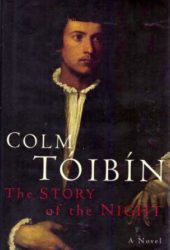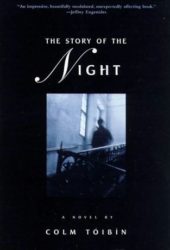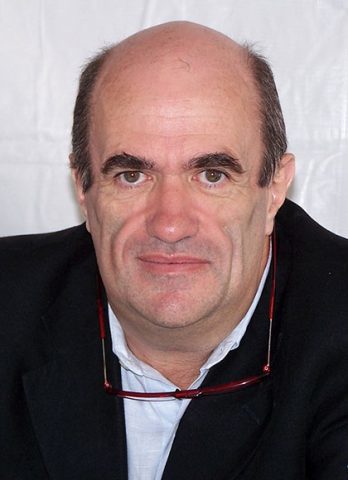 The Story of the Night
The Story of the Night
by Colm Tóibín
Published by Henry Holt & Co.
American edition published June, 1997
Genre (subgenre)
324 pgs. • Find on Amazon.com
Reviewed by Stephen O. Murray
November 26, 2000
The talented Irish writer Colm Tóibín is fascinated by repression and self-suppression in more southern climes.[1]Since then, Tóibín has published other books including The Master and Brooklyn. His first novel, The South, deals with the long aftermath of the Spanish Civil War; Homage to Barcelona focuses on the Catalan capital,; and his travel book, The Sign of the Cross, recounts travels in Spain, Italy, and the Balkans.
The Story of the Night, his third novel, is set in the Argentina of mid-1970s, during the brutal and inept rule of General Galiteri.
Richard Garay, the exceedingly unheroic narrator, grew up smothered by a lonely mother who was born in England and never much acculturated to Argentina, even before she was widowed when Richard was young. Richard makes some money teaching English to the children of upper-class Argentines, cares for his mother (who dies about a quarter of the way through the book), and occasionally comes partly alive in bathhouse sex with men who do not think of themselves as gay.
It would be very difficult for any reader to miss the parallel between the suppression of knowledge about their sexuality of Richard and his sexual partners and the Galiteri regime’s suppression of information about those who were “disappeared,” often hurled out from helicopters flying over the ocean. Richard’s lack of knowledge of what is going on around him fits with his determination that no one know anything about his desires and sexual practices. Everyone in the superficially proper Latino society is trained to see nothing, to say nothing, not to know even what they and everyone else know.
 Despite sharing what I call “the will not to know” what is going on in Argentina, Richard comes into contact with others who have Plans for different futures for the country. As befits his bicultural heritage, these include an Argentine politician and some American operatives.
Despite sharing what I call “the will not to know” what is going on in Argentina, Richard comes into contact with others who have Plans for different futures for the country. As befits his bicultural heritage, these include an Argentine politician and some American operatives.
Richard begins a love affair with Jorge Canetto, the elder brother of one of the youth he tutors in English. Jorge’s father wants to run for president, to become another Juan Peron. Richard become marginally involved with the campaign even as his relationship with Jorge disintegrates.
As an Anglo who understands local culture, Richard is also recruited by Susan and Donald Ford to work for the Institute for Economic Development, a vaguely World Bankish enterprise that is a CIA front. The Fords are preparing to aid multinational corporations to pick up at bargain rates various state-owned business enterprises when the regime collapses. Richard makes substantial profit for himself on a shady oil deal.
The kind of cartoonish maneuvering reminded me of Graham Greene’s Our Man in Havana, which,what must have seemed most absurd in that book when it was written, was almost a blueprint for what happened later. Richard is not as comic a figure as the British spy in Greene’s novel, though he would not be out of place elsewhere in the anguished company of protagonists in Greens’ work (Greeneland, as it widely labeled). A better analog is the alienated protagonist of Chang-Rae Lee’s haunting novel Native Speaker (which also foreshadowed the fall of a Korean-American congressman, thereby providing another instance of reality imitating art).
The rule of the generals collapses after the ignonimous defeat in the Falkland/Malvinas and—well, the book takes a radical turn from being a book about neoliberal maneuverings and old-fashioned, corrupt Latin American authoritarianism as viewed by an alienated gay semi-outsider.
The last third of the book connects better with the first part than what immediately precedes it. The third part is about Richard and the third of the Canetto brothers, Pablo, being destroyed by AIDS. This basic story has not been told very often in Latin American contexts, but it has been told in English by a number of writers (including Paul Monette, Mark Doty, Fenton Johnson, Adam Mars-Jones, Edmund White) with searing experiences.
In the last third of The Story of the Night, the specificity of the Argentine world dissolves. The vigil in the house by the sea could occur most anywhere. The frustrations and disappointments with physicians seem no different in Argentina than in the U.S., etc.
Numbness is almost inevitable when confronted with the deteriorating health of a loved one, but Richard was already numb before AIDS engulfed him and Pablo. This undercuts any dramatic descent into despair. Richard never belonged to any community larger than a dyad: first with his mother, then with Jorge, then with Pablo.

I think of understatement as British, and it is Richard’s British side who narrates the book. Opera in Romance languages is filled with passionate arias. If Tóibín were writing an opera, it would be more like those of Benjamin Britten, with lots of recitative and dialogue, but not memorable arias. Tóibín makes the character believable and even made me care about very self-centered (gay and straight) characters. The combination of events and relationships require more willful suspension of disbelief from me than does accepting the characters.
Although I don’t think the three main parts of the book fit together well, there is a unity of voice and tone weaving what seem like quite different books (a spy novel, an AIDS novel, and a novel of alienated exile) into a single narrative. Tóibín is a very gifted writer, and I fear that I have failed to do justice to the great accomplishments of this book or to explain why I was totally absorbed with it while I was reading it. Novels need not unfold smoothly, and Tóibín is not the first novelist to stuff too many disparate experiences between the covers of a single book. The construction is not elegant, but the prose style and characterization are.
published by epinions, 26 November 2000
©2000, 2016, Stephen O. Murray

